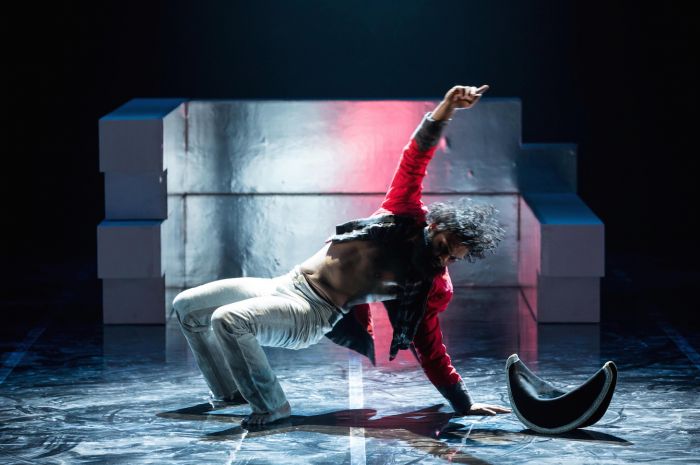The mesmerising opening scene, “Respecting the Space”, establishes the sacredness of the bond between people and nature. A glowing circle, symbol of wholeness, floats above and is reflected below, and to either side, the dancers emerge, the women linked together in softer pose, and the men banded together, strong and sure of their stance. Smoke swirling outwards from the circle in clouds and the silvery sheaves of leaves attached to the dancers suggest cosmos and country. Into this world, Bennelong (Beau Dean Riley Smith) is birthed.
The beauty of this image remains with us throughout the tragic narrative reminding us of what was, and is, at stake for the First Peoples. The crushing of the way of life lyrically conveyed through “Wangal” is well evoked by the sheer massiveness of the scarlet numbers, 1788, that fill the back space, to become inscribed on the land and its people alike. The sacred circle is to be replaced in “Rewind” by a grim rectangle imprisoning, but not destroying, the Spirit of the Land (an always deeply immersed Elmer Kris).
At first contact the two cultures size each other up, Phillip (Daniel Riley) is curious and assured but his costume (Jennifer Irwin is so clever) manages to suggest how “out of place” he is, as do his alien, attenuated movements. Bennelong is also curious but his gestures are cautious, puzzled, although the magnetic attraction between the two males, or perhaps cultures, is evident. In “Bait” Bennelong is literally captured by Philip and in “Responding” metaphorically assimilated, allowing himself to be clothed in European style with its emphasis upon separation from nature and mastery of the material world.
“Onslaught”, a smallpox epidemic, is a reference to the disease of Europeanism, which, while bringing an agonising death to many of his clan, permits Bennelong to survive. He chooses to adapt to the new regime or is it that he attempts reconciliation or even the possibility of peaceful coexistence through mutual understanding? While Bennelong provides a contrasting model to Pemulwuy (Waangenga Blanca) who in “Resistance” and “Rejection” radiates the energy of a confident warrior, his path is more complex, less easily appraised.
Beau Dean Riley Smith’s Bennelong is a man always in a dilemma, struggling to assimilate the ways of another culture, yet witness to its joyless arrogance at court in England and its cruel disregard of the death of his Eora companion, Yemmerawanye. A mere novelty in England, on his return he is an outsider in his own land, the bicorn hat he once wore as an honour now a curse upon his head. Bewildered, rejected and hurt, in turn abusing the feminine energy that supported him, the last image we have of him is as a desperate man enclosed in a silver tomb, the walls reflecting back to him an image of himself he doesn’t want to see.
It seems that in telling this story, and telling it in a way that resembles “stations” as in Stations of the Cross, the work asks the audience to respond to each “picture” and consider the meaning of Bennelong’s story. He remains a much contested figure, unlike the leader of resistance, Pemulwuy, who has hero status. But we serve in different ways and the wonderful Team Bangarra – the company of finely honed and discipline-honed 18 dancers, the atmospheric soundscapes of Steve Francis, the input of Matthew Doyle, the evocative minimal sets of Jacob Nash, sensitively lit by Nick Schlieper, the imaginative, spot-on costumes, the valuable assistance of dramaturg Alana Valentine, and above all the choreography of Stephen Page – use dance itself as site of resistance to the imprisonment of Bennelong in a categorical judgement.





